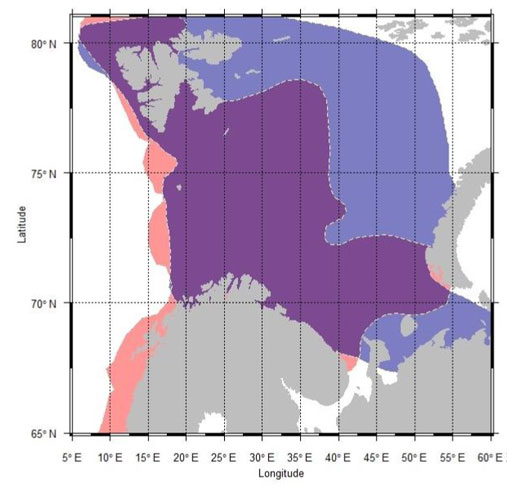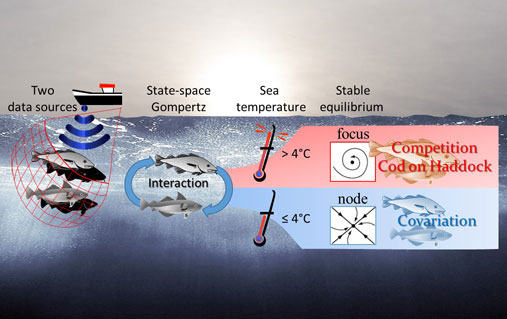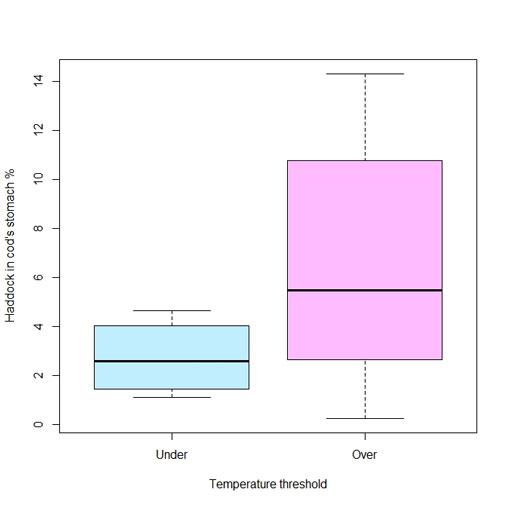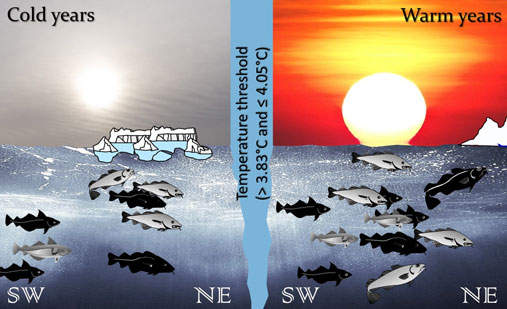Climate change has profound ecological effects. High latitude regions, such as Arctic and Boreal seas, are highly sensitive to climate change (Frainier et al. 2017). Since the early 90s, global temperatures have been steadily increasing and affecting the distribution of Arcto-boreal species and their life cycle. In the Barents Sea, northeast Arctic haddock has a distribution and life cycle very similar to its bigger cousin the northeast Arctic cod. Recent years have shown an increase of both cod and haddock population in the Barents Sea linked to a sea temperature increase.
Could the haddock and the cod interact?
The interactions among species can shift repeatedly because of changes in the environment. While the environment is changing all the time (e.g. at a seasonal or daily basis) the recent climate warming is creating a direction to this change. The increase of the global temperatures have been a major motivation for investigating a plethora of effects on biological systems, e.g., distribution, behaviour, phenology etc…
Atlantic cod and haddock are two gadoid species of high economic importance, closely related, that co-occur in many regions in the North Atlantic such as the Barents Sea (Figure 2), the North Sea and the Georges bank in Canada’s waters. Cod and haddock have an overlapping diet at the larval stage, and are potential competitors at this stage, but are more segregated diet when adults. At the adult stage, Cod have a more fish-oriented diet than haddock that feed more on benthic prey. Adult cod then prey on haddock (see post).

To explore the interaction between these two species in the Barents Sea, we used a state-space Gompertz model on a combined acoustic and trawl survey data set covering 33 years. In this study, published in Global Change Biology (Durant et al. 2020), we showed that the interaction is non-linear. Over a sea temperature of 4 °C the cod and haddock populations, that were otherwise co-varying, start a competition relationship, the cod negatively affecting the haddock changing the shape of the interaction of these two species (Figure 3).

Why temperature affects the haddock-cod interaction?
In the Barents Sea, the cod and haddock stocks are near the northern temperature boundary of their species’ overall habitat range and are thus expected to be particularly responsive to temperature changes. Landa et al. (2014) examined the connections between sea temperature, abundance and distribution boundaries of haddock in the Barents Sea between 1981 and 2008. They found a positive relationship between temperature and abundance. Likewise, they show that, on a long term, distribution of haddock in the Barents Sea was also affected by temperature increase leading to a North-eastwards distribution shift, particularly for younger age-class of haddock (see post). They suggest that a combination of continued increasing abundance of NEA haddock and increasing temperature are likely to result in further North-eastwards distribution shifts.

In our study (Durant et al. 2020), we showed a change in these species interaction with increase of temperature. The cod effect on haddock that was positive (indicating a covariation) becomes negative (indicating a competition or predation) with the increase of temperature, a trend of recent years. This change in interaction was also visible in the cod diet (Figure 4). Indeed, recent analyses of Barents Sea cod stomach contents showed a significant increase of the proportion of haddock (mainly smaller ones) in their diet since 1984 (Holt et al. 2019). This change in diet may be linked to the distribution change of the two species with climate warming and the increase of the mean size of the NEA cod in recent years, the haddock being present in a larger number in the diet of larger cod than in smaller cod one (see post).
Reference:
Bakketeig I.E., Hauge M., Kvamme C., Sunnset B.H., Toft K.Ø. 2016. Havforskningsrapporten 2016. Fisken og havet, 1, 99.
Durant J.M., Ono K., Stenseth N.C., Langangen Ø. 2020. Non-linearity in interspecific interactions in response to climate change: cod and haddock as an example. Global Change Biology, doi:10.1111/gcb.15264.
Frainer A., Primicerio R., Kortsch S., Aune M., Dolgov A.V., Fossheim M. et al. (2017). Climate-driven changes in functional biogeography of Arctic marine fish communities. Proceedings of the National Academy of Sciences, 114, 12202-12207.
Holt, R.E., Bogstad, B., Durant, J.M., Dolgov A.V., Ottersen, G. 2019. Barents Sea cod (Gadus morhua) diet composition: long-term interannual, seasonal, and ontogenetic patterns. ICES Journal of Marine Science DOI: 10.1093/icesjms/fsz082
Landa C.S., Ottersen G., Sundby S., Dingsør G.E., Stiansen J.E. (2014). Recruitment, distribution boundary and habitat temperature of an arcto-boreal gadoid in a climatically changing environment: a case study on Northeast Arctic haddock (Melanogrammus aeglefinus). Fisheries Oceanography, 23, 506-520.

Log in to comment
Not UiO or Feide account?
Create a WebID account to comment